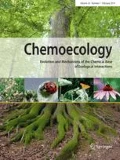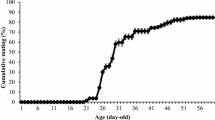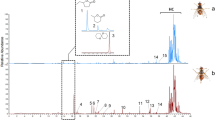Abstract
The interactions between Dacini male fruit flies and phytochemical male lures are unique. Lure response, fate and its effects after consumption on fruit fly mating behaviour are species- and lure-specific. Bactrocera frauenfeldi is known to respond to the phenylbutanoids raspberry ketone (RK) and cue lure (CL), anisyl acetone (AA), and zingerone (ZN), which are produced by some rainforest orchids. Here we compared the relative field responses of B. frauenfeldi males to these phenylbutanoids in two selected locations to determine the most attractive lure for this species. We also performed gas chromatographic-mass spectral analyses of male rectal pheromone glands to understand the fate of the ingested compounds. Results showed that B. frauenfeldi males were most responsive to CL, equally to RK and AA, while poorly to ZN in Cairns, a site with high population density. No significant difference was observed in Lockhart River which has a low population density of B. frauenfeldi. Chemical analyses showed that most of the ingested phenylbutanoids were sequestered into rectal glands, either unchanged or with minimal structural changes except for AA, which is converted to RK via a demethylation of the methoxy- to a hydroxy-moiety and reduced to 4-(4-methoxyphenyl)-2-butanol via the keto-moiety. This study provides both practical and ecological implications: it identified the most attractive lure, which is important for monitoring and management of B. frauenfeldi; and based on the relative responses, conversion and retention rates by B. frauenfeldi males, revealed the ecological significance of these phytochemical lures in plant-fruit fly co-evolution.



Similar content being viewed by others
References
Barthel WF, Green N, Keiser I, Steiner LF (1957) Anisylacetone, synthetic attractant for male melon fly. Science 126:3275
Cunningham RT (1989) Biology and physiology: parapheromones. In: Robinson AS, Hooper G (eds) Fruit flies: their biology, natural enemies and control, world crop pests 3(A). Elsevier, Amsterdam, pp 221–230
Deifel A (1989) 4-(4-Hydroxyphenyl)-2-butanone (raspberry ketone). Review of natural occurrence and biogenesis. (in German) Z. Lebensm Unters Forsch 188:330–332
Doorenweerd C, Leblanc L, Norrbom AL, San Jose M, Rubinoff D (2018) A global checklist of the 932 fruit fly species in the tribe Dacini (Diptera: Tephritidae), Zookeys (730): 19–56.Drew RAI (1974) The response of fruit fly species (Diptera: Tephritidae) in the South Pacific area to male attractants. J Aust Entomol Soc 13:267–270
Drew RAI (1989) The tropical fruit flies (Diptera: Tephritidae: Dacinae) of the Australasian and Oceanian Regions. Mem Qld Mus 26:1–521
Fay HAC (2012) A highly effective and selective male lure for Bactrocera jarvisi (Tryon) (Diptera: Tephritidae). Aust J Entomol 51:189–197
GenStat (2016) GenStat for Windows, Release 16.1. VSN International Ltd., Oxford
Hancock DL, Hamacek EL, Lloyd AC, Elson-Harris MM (2000) The distribution and host plants of fruit flies (Diptera: Tephritidae) in Australia. Queensland Department of Primary Industries Information Series Q199067, Brisbane
Hanssen BL (2015) Synthesis and analysis of zingerone analogues as fruit fly attractants. MSc. Thesis, Department of Chemistry and Biomolecular Sciences, Macquarie University, Sydney, Australia
Hee AKW, Tan KH (1998) Attraction of female and male Bactrocera papayae to conspecific males fed with methyl eugenol and attraction of females to male sex pheromone components. J Chem Ecol 24:753–764
Hee AKW, Tan KH (2004) Male sex pheromonal components derived from methyl eugenol in the hemolymph of the fruit fly Bactrocera papayae. J Chem Ecol 30:2127–2138
IAEA (International Atomic Energy Agency) (2003) Trapping guidelines for area-wide fruit fly programmes. Joint FAO/IAEA Division, Vienna, p 47
Katte Y, Tan KH, Su ZH, Hajime O, Nishida R (2020) Floral fragrances in two closely related fruit fly orchids, Bulbophyllum hortorum and B. macranthoides (Orchidaceae): assortments of phenylbutanoids to attract tephritid fruit fly males. Appl Entomol Zool 55:55–64
Kumaran N, Clarke AR (2014) Indirect effects of phytochemicals on offspring performance of Queensland fruit fly, Bactrocera tryoni (Diptera: Tephritidae). J Appl Entomol 138:361–367
Kumaran N, Hayes RA, Clarke AR (2014a) Cuelure but not zingerone make the sex pheromone of male Bactrocera tryoni (Tephritidae: Diptera) more attractive to females. J Insect Physiol 68:36–43
Kumaran N, Prentis PJ, Mangalam KP, Schutze MK, Clarke AR (2014b) Sexual selection in true fruit flies (Diptera: Tephritidae): transcriptome and experimental evidences for phytochemicals increasing male competitive ability. Mol Ecol 23:4645–4657
Leblanc L, William J, Allwood AJ (2004) Host fruit of mango fly (Bactrocera frauenfeldi (Schiner)) (Diptera: Tephritidae) in the Federated States of Micronesia. Micronesica 37:21–31
Leblanc L, Vueti ET, Drew RAI, Allwood AJ (2012) Host plant records for fruit flies (Diptera: Tephritidae: Dacini) in the Pacific islands. Proc Hawaii Entomol Soc 44:11–53
Leblanc L, Doorenweerd C, Jose MS, Sirisena UGAI, Hemachandra KS, Rubinoff D (2018a) Description of a new species of Dacus from Sri Lanka, and new country distribution records (Diptera, Tephritidae, Dacinae). ZooKeys 795:105–114
Leblanc L, Doorenweerd C, Jose MS, Pham HT, Rubinoff D (2018b) Descriptions of four new species of Bactrocera and new country records highlight the high biodiversity of fruit flies in Vietnam (Diptera, Tephritidae, Dacinae). ZooKeys 797:87–115
Leblanc L, Hossain MA, Doorenweerd C, Khan SA, Momen M, San Jose M, Rubinoff D (2019) Six years of fruit fly surveys in Bangladesh: a new species, 33 new country records and discovery of the highly invasive Bactrocera carambolae (Diptera, Tephritidae). ZooKeys 876:87–109
Metcalf RL, Metcalf ER (1992) Plant kairomones in insect ecology and control. Chapman and Hall, New York
Metcalf RL, Metcalf ER, Mitchell WC, Lee LWY (1979) Evolution of olfactory receptor in oriental fruit fly Dacus dorsalis. Proc Natl Acad Sci USA 76:1561–1565
Metcalf RL, Mitchell WC, Metcalf ER (1983) Olfactory receptors in the melon fly Dacus cucurbitae and the oriental fruit fly Dacus dorsalis. Proc Natl Acad Sci USA 80:3143–3147
Nakahira M, Ono H, Wee SL, Tan KH, Nishida R (2018) Floral synomone diversification of Bulbophyllum sibling species (Orchidaceae) in attracting fruit fly pollinators. Biochem Syst Ecol 81:86–95
Nishida R, Tan KH (2016) Search for new fruit fly attractants from plants: A review. In: Sabater-Munoz B, Vera T, Pereira R, Orankanok W (eds) Proceedings of the 9th international symposium on fruit flies of economic importance, 12–16 May 2014, Bangkok, Thailand, pp 249–262
Nishida R, Tan KH, Takahashi S, Fukami H (1990) Volatile components of male rectal glands of the melon fly, Dacus cucurbitae Coquillett (Diptera: Tephritidae). Appl Entomol Zool 25:105–112
Nishida R, Iwahashi I, Tan KH (1993) Accumulation of Dendrobium (Orchidaceae) flower fragrance in the rectal glands by males of the melon fly, Dacus cucurbitae (Tephritidae). J Chem Ecol 19:713–722
Noushini S, Perez J, Park SJ, Holgate D, Alvarez VM, Jamie I, Jamie J, Taylor P (2020) Attraction and electrophysiological response to identified rectal gland volatiles in Bactrocera frauenfeldi (Schiner). Molecules 25:1275
Park SJ, Morelli R, Hanssen BL, Jamie JF, Jamie IM, Siderhurst MS, Taylor PW (2016) Raspberry ketone analogs: vapour pressure measurements and attractiveness to Queensland Fruit Fly, Bactrocera tryoni (Froggatt) (Diptera: Tephritidae). PLoS ONE 11:1–16
Rabiatul AS, Wee SL (2019) Zingerone improves mating performance of Zeugodacus tau (Diptera: Tephritidae) through enhancement of male courtship activity and sexual signaling. J Insect Physiol 119:103949. https://doi.org/10.1016/j.jinsphys.2019.103949
Royer JE (2015) Responses of fruit flies (Tephritidae: Dacinae) to novel male attractants in north Queensland, Australia, and improved lures for some pest species. Austral Entomol 54:411–426
Royer JE, Wright CL, Hancock DL (2016) Bactrocera frauenfeldi (Diptera: Tephritidae), an invasive fruit fly in Australia that may have reached the extent of its spread due to environmental variables. Aust Entomol 55:100–111
Royer JE, Agovaua S, Bokosou J, Kurika K, Mararuai A, Mayer DG, Niangu B (2018) Responses of fruit flies (Diptera: Tephritidae) to new attractants in Papua New Guinea. Aust Entomol 57:40–49
Royer JE, Mille C, Cazeres S, Brinon J, Mayer DG (2019) Isoeugenol, a more attractive male lure for the cue-lure-responsive pest fruit fly Bactrocera curvipennis (Diptera: Tephritidae: Dacinae), and new records of species responding to zingerone in New Caledonia. J Econ Entomol 112:1502–1507
Royer JE, Tan KH, Mayer DG (2020) Comparative trap catches of male Bactrocera, Dacus and Zeugodacus fruit flies (Diptera: Tephritidae) with four floral phenylbutanoid lures (anisyl acetone, cue-lure, raspberry ketone and zingerone) in Queensland, Australia. Environ Entomol nvaa056
Segura DF, Belliard SZ, Vera MT, Bachmann GE, Ruiz MJ, Jofre-Barud F, Fernández PC, López ML, Shelly TE (2018) Plant chemicals and the sexual behavior of male Tephritid fruit flies. Ann Entomol Soc Am 111:239–264
Shelly TE (2010) Effects of methyl eugenol and raspberry ketone/cue lure on the sexual behavior of Bactrocera species (Diptera: Tephritidae). Appl Entomol Zool 45:349–361
Shelly TE (2017) Zingerone and the mating success and field attraction of male melon flies (Diptera: Tephritidae). J Asia-Pac Entomol 20:175–178
Shelly TE, Dewire AM (1994) Chemically mediated mating success in male oriental fruit flies (Diptera: Tephritidae). Ann Entomol Soc Am 87:375–382
Tan KH, Nishida R (1995) Incorporation of raspberry ketone in the male rectal glands of the Queensland fruit fly, Bactrocera tryoni (Froggatt) (Diptera: Tephritidae). Appl Entomol Zool 30:494–497
Tan KH, Nishida R (1996) Sex pheromone and mating competition after methyl eugenol consumption in the Bactrocera dorsalis complex. In: McPheron BA, Steck GJ (eds) Fruit fly pests—a world assessment of their biology and management. St.Lucie Press, Florida, pp 147–153
Tan KH, Nishida R (1998) Ecological significance of male attractant in the defence and mating strategies of the fruit fly pest, Bactrocera papayae. Entomol Exp Appl 89:155–158
Tan KH, Nishida R (2000) Mutual reproductive benefits between a wild orchid, Bulbophyllum patens, and Bactrocera fruit flies via a floral synomone. J Chem Ecol 26:533–546
Tan KH, Nishida R (2005) Synomone or kairomone? Bulbophyllum apertum flower releases raspberry ketone to attract Bactrocera fruit flies. J Chem Ecol 31:497–507
Tan KH, Nishida R (2007) Zingerone in the floral synomone of Bulbophyllum baileyi (Orchidaceae) attracts Bactrocera fruit flies during pollination. Biochem Syst Ecol 31:334–341
Tan KH, Nishida R (2012) Methyl eugenol: Its occurrence, distribution, and role in nature, especially in relation to insect behavior and pollination. J Insect Sci 12:56
Tan KH, Nishida R (2015) Pollination of bactrocerophilous Bulbophyllum orchids. In: Elliott J, Kuraweil HF, O’Byrne P, Tan KW, van Schans AS, Wong SM, Yam TW (eds) Proceedings of the 20th world orchid conference, Singapore, pp 273–279
Tan KH, Nishida R, Jang EB, Shelly TE (2014) Pheromones, male lures, and trapping of tephritid fruit flies. In: Shelly TE, Epsky N, Jang EB, Reyes-Flores J, Vargas RD (eds) Trapping and the detection, control, and regulation of tephritid fruit flies. Springer, Dordrecht, pp 15–74
Vargas RI, Leblanc L, Pinero JC, Hoffman KM (2014) Male annihilation, past, present, and future. In: Shelly TE, Epsky N, Jang EB, Reyes-Flores J, Vargas RD (eds) Trapping and the detection, control, and regulation of tephritid fruit flies. Springer, Dordrecht, pp 493–511
Wee SL, Shelly TE (2013) Capture of Bactrocera fruit flies in traps baited with liquid versus solid formulations of male lures in Malaysia. J Asia-Pac Entomol 16:37–42
Wee SL, Hee AKW, Tan KH (2002) Comparative sensitivity to and consumption of methyl eugenol in three Bactrocera dorsalis (Diptera: Tephritidae) complex sibling species. Chemoecology 12:193–197
Wee SL, Tan KH, Nishida R (2007) Pharmacophagy of methyl eugenol by males enhances sexual selection of Bactrocera carambolae. J Chem Ecol 33:1272–1282
Wee SL, Abdul Munir MZ, Hee AKW (2018a) Attraction and consumption of methyl eugenol by male Bactrocera umbrosa Fabricius (Diptera: Tephritidae) promotes conspecific sexual communication and mating performance. Bull Entomol Res 108:116–124
Wee SL, Chinvinijkul S, Tan KH, Nishida R (2018b) A new and highly selective male lure for the guava fruit fly Bactrocera correcta. J Pest Sci 91:691–698
Wee SL, Peek T, Clarke AR (2018c) The responsiveness of Bactrocera jarvisi (Diptera: Tephritidae) to two naturally occurring phenylbutaonids, zingerone and raspberry ketone. J Insect Physiol 109:41–46
Acknowledgements
The authors would like to thank Sybilla Oczkowicz (DAF, Cairns) for pupae supply, Stacey Carseldine and John Pritchard (contracted by DAF) for assistance with field trials. The critical review of this manuscript by R. Nishida (Kyoto University) and two anonymous reviewers are much appreciated. The Central Analytical Research Facility operated and provided by the Institute for Future Environments, Queensland University of Technology, Australia was also greatly appreciated. The work is partly supported by International Atomic Energy Agency Research Contract 20443 (@ST-2016-004) and the Australian Endeavour Research Fellowship 2016 (5596-2016) awarded to S. L. Wee.
Author information
Authors and Affiliations
Contributions
SLW, KHT and JR conceived and designed the experiments. SLW, JR and JH performed the experiments. SLW and DM analysed the data. SLW, KHT and JR wrote the paper. All authors read and approved the manuscript.
Corresponding author
Ethics declarations
Conflict of interest
The authors have declared that no conflict of interest exists.
Ethical approval
This article does not contain any studies with human participants or animals (vertebrates) performed by any of the authors.
Additional information
Communicated by Günther Raspotnig.
Rights and permissions
About this article
Cite this article
Wee, S.L., Royer, J.E., Herring, J. et al. Relative response of male Bactrocera frauenfeldi (Diptera: Tephritidae) to phenylbutanoid phytochemicals: implications for fruit fly control and plant–insect interactions. Chemoecology 30, 305–314 (2020). https://doi.org/10.1007/s00049-020-00320-6
Received:
Accepted:
Published:
Issue Date:
DOI: https://doi.org/10.1007/s00049-020-00320-6




